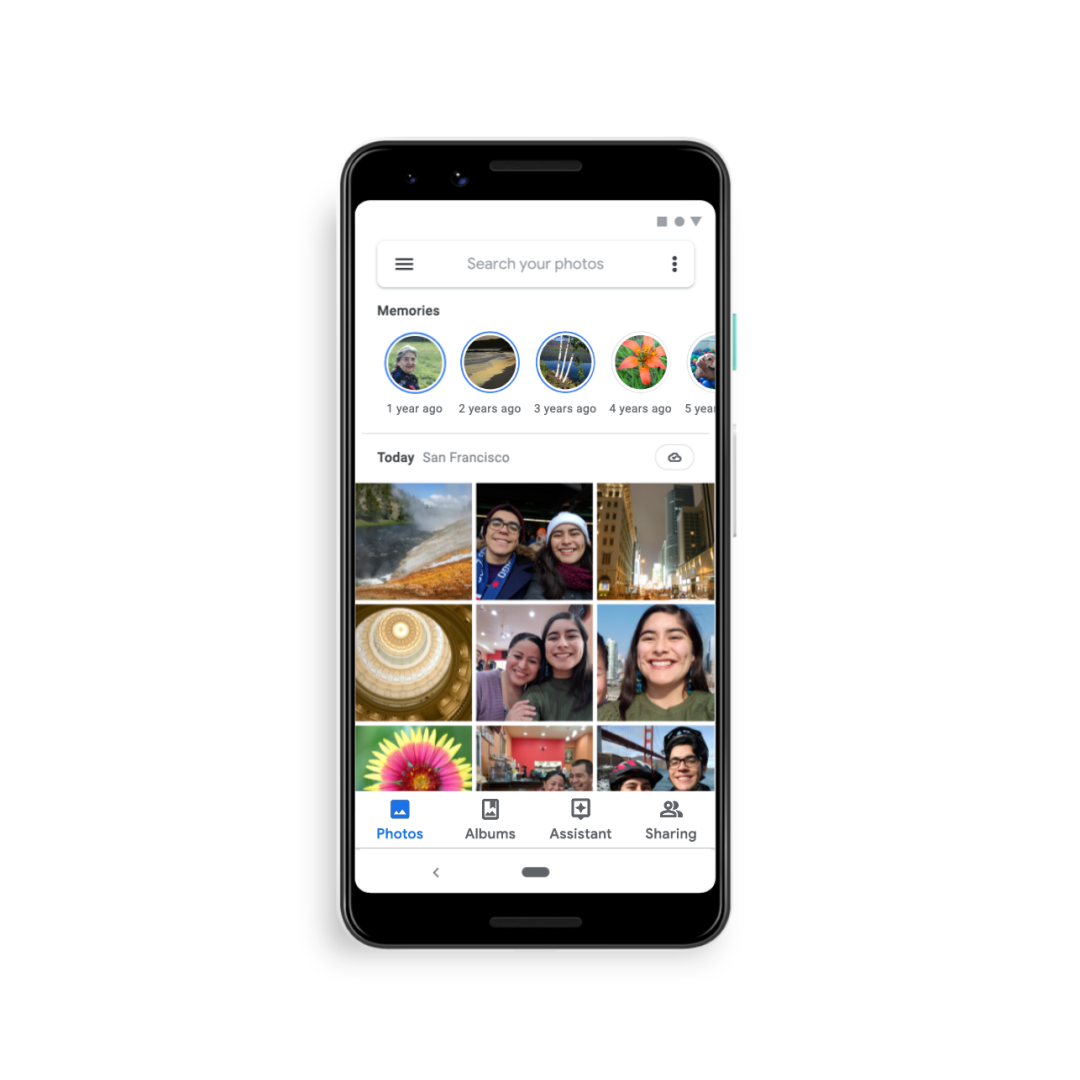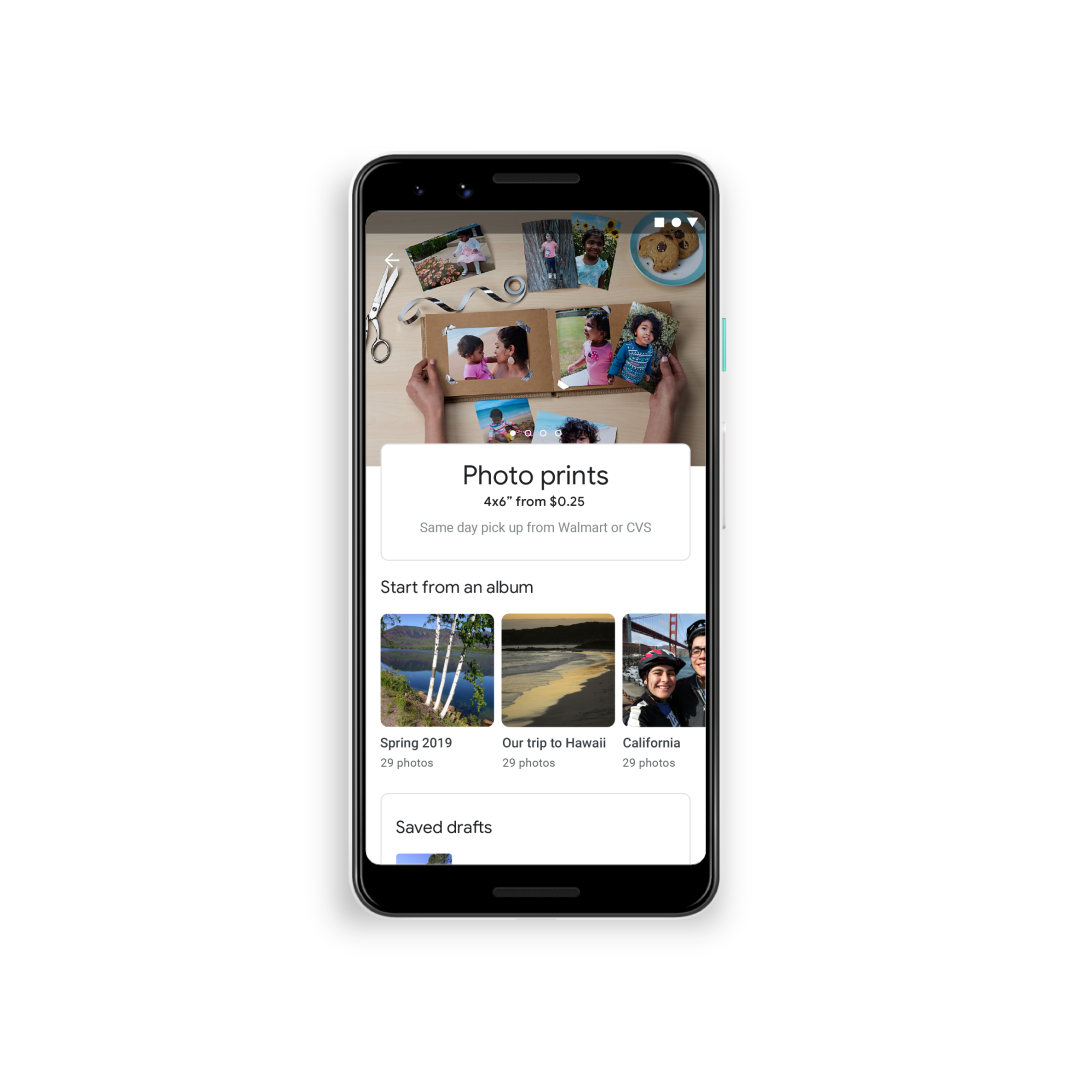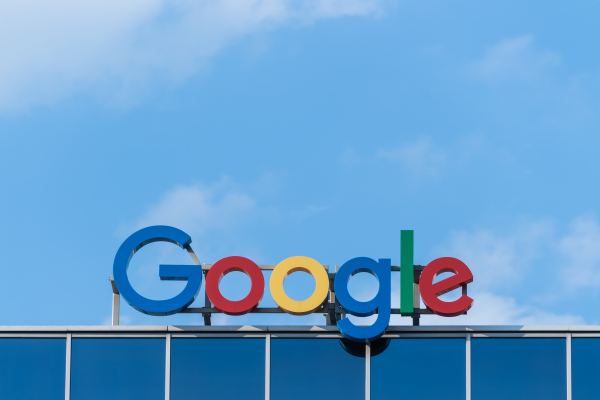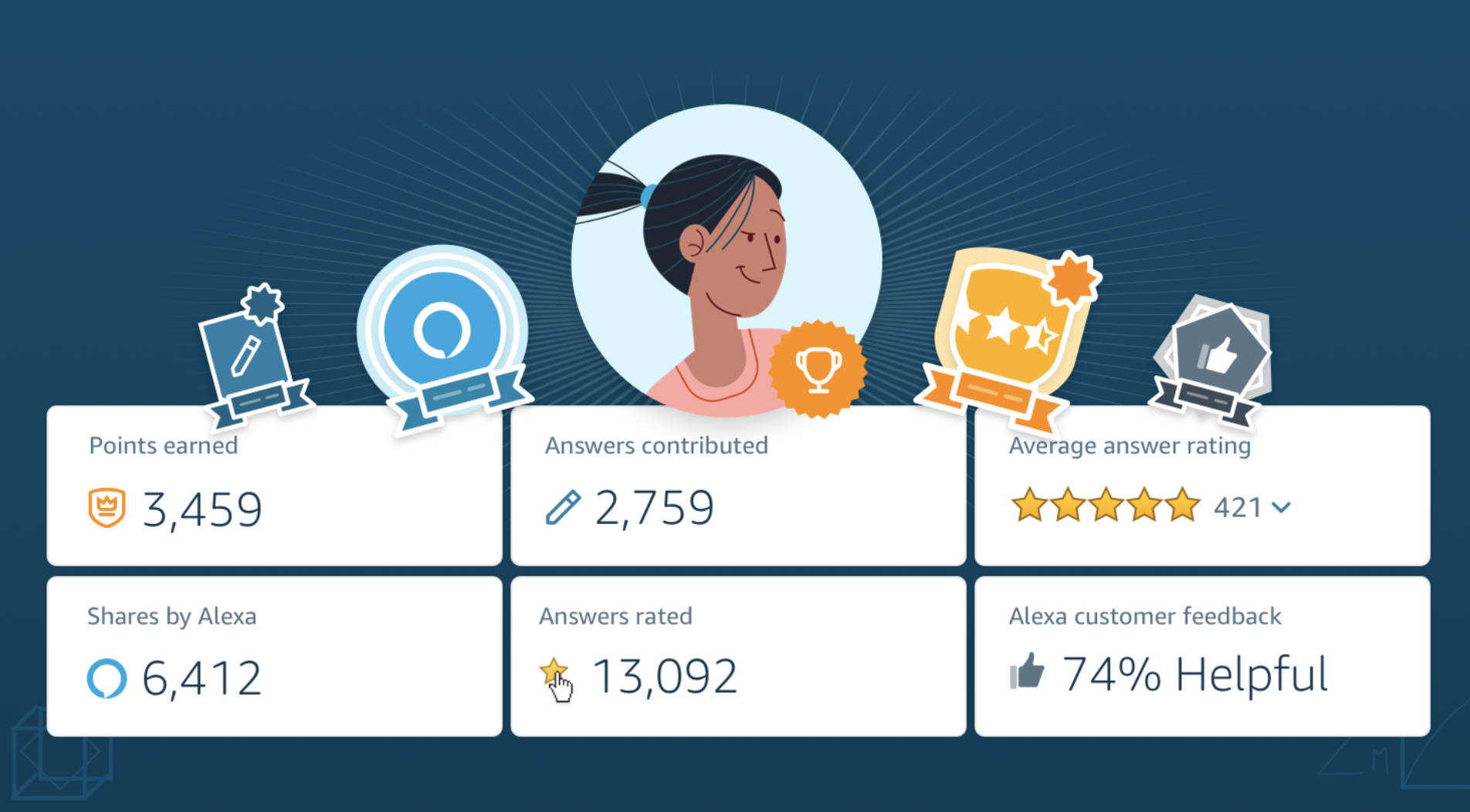Music
Trailers
DailyVideos
India
Pakistan
Afghanistan
Bangladesh
Srilanka
Nepal
Thailand
StockMarket
Business
Technology
Startup
Trending Videos
Coupons
Football
Search
Download App in Playstore
Download App
Best Collections
Technology
Google Photos is getting its own version of Stories. But instead of focusing on what you&re doing now, as Stories on other platforms like Instagram and Snapchat offer, Google Photos is adopting the format to help you take a trip down memory lane. The feature is one of several updates coming to the photo-sharing service that focuses on helping you reconnect with your old photos that often get forgotten after upload.
Its unique take on Stories is, perhaps, the most interesting update, as itthe first time we&ve seen the format used as a way to rewind time.
In Google Photos, the feature is more appropriately called &Memories,& and is designed to help users relive their life in a more meaningful way.

The company said it came up with the idea by watching user behavior on its app.
&We see users browse their photos and scroll all the way down to look at pictures from five years ago,& explained Google Photos lead, Shimrit Ben-Yair. &We see them searching for moments and having a good experience with that. But we thought, how can we make that even easier?&
The Memories feature, she continued, is meant to accomplish that by helping users &better reminisce digitally.&
Most users will already know how to use Google Photos Memories, given the broad adoption of Stories across various platforms, including Instagram, Snapchat, Facebook, Messenger, YouTube and even surprising places like Netflix. As with some other implementations, the feature places small, rounded icons at the top of the Google Photos gallery, which you can tap to launch and advance through.
Except, in this case, each Story circle is taking you back in time — for example, a year ago, two years ago, three and so on.

However, the feature isn&t just a variation on &Rediscover this Day,& because itnot as tightly tied to a particular date. Itmore like a showcase of what you were doing around the same time as in years prior — like around the same week. It lets you look back without having to swipe through the badly shot photos and duplicates.
To help users from reliving more sensitive memories — like deaths they&re still grieving or breakups they&d rather forget, for example — you&ll also be able to block certain people or places from showing up in the Memories feature, to better personalize your highlight reel.
Another key difference is that Google Photos& Memories are not put on public display.
&Even though it is the Stories format — which we lean into because we feel it creates a more immersive experience for reliving your life — this is only your library. Ityour private content,& noted Google Photos Engineering lead James Gallagher, when demoing the feature, pre-launch, to TechCrunch.
In a few months& time, however, Google Photos plans to let you share these old photos — or any others you come across in your library — in a more direct and more personal way. Through an enhancement to the sharing feature, you&ll be able to send a photo directly to friends or family, where itthen adding to an ongoing and private conversation that will eventually become a stream of all your chats and shares.

And Google Photos is expanding its options for getting photos off your phone and into the real world.
Itpartnering with Walmart and CVS for 4×6 photo prints that can be picked up in about an hour at more than 11,000 U.S. locations. These prints will cost the same as if you ordered through the retailers directly ($0.25 from Walmart and $0.33 from CVS). You&ll also be able to turn photos into wall art of various sizes, in the U.S. This follows Flickrrecent expansion into the area of prints and wall art, which rolled out last month.

In Google Photos& case, you&ll be able to select canvas prints in three different sizes, 8×8 ($19.99), 11×14 ($29.99) and 16×20 ($44.99), which can be customized with either black, white or photo wrap borders. The canvases also come with a wire hanger on the back to make mounting easier.
This feature will generate revenue, though Google outsources the actual work to a network of printing partners across the U.S. It joins an existing feature that lets users turn photos into photo books in just a few steps.

One final feature, though not necessarily related to reminiscing, is an improvement to search that will now help you find photos or screenshots with text — like a recipe.
This feature, prints and the Memories feature are rolling out now. Direct sharing is coming in a few months.
The additions are part of many enhancements to Google Photos since its spin-out from Google+ just over four years ago. The company has rapidly improved its photo-hosting and sharing service with AI functionality to clean up users& vast photo libraries and automatically create photo edits and mini-movies, among other things. And it continues to improve with features like support for Lens& visual search and an expanded array of AI-powered photo fixes, for example.
Thanks to these features and its integration with the Android operating system, Google Photos now has more than a billion monthly users.
- Details
- Category: Technology

After years of back and forth with tax authorities in France, Google has settled a fiscal fraud probe, as the financial prosecutoroffice told Reuters and AFP. Overall, Google will pay a $549 million fine as well as $510 million in back taxes (€500 million and €465 million, respectively).
This is a settlement, which means that French authorities are dropping charges against Google in France. It covers activities from 2005 to 2018.
According to previous reports, the company owed around $1.3 billion in taxes. In 2014, Google started putting aside some money for a potential fine.
This is a classic story of corporate tax optimization in Europe. For multiple years, Google allegedly issued advertising contracts from its European headquarters in Ireland. Profits generated from those contracts would be taxed in Ireland.
Separately, France has been working on a tax on tech giants. In order to avoid tax optimization schemes, big tech companies that generate significant revenue in France are taxed on their revenue generated in France.
If you&re running a marketplace or advertising company that generates more than €750 million in global revenue and €25 million in France, you have to pay 3% of your French revenue in taxes.
It has generated some drama with the U.S. — President Donald Trump first said that the U.S. would be placing tariffs on French wines.
France and the U.S. eventually reached an agreement at the Group of Seven summit. The French government now hopes that the OECD finds a way to properly tax tech companies in countries where they operate in order to scrap the French tax.
- Details
- Category: Technology
Read more: Google to pay $549 million fine and $510 million in back taxes in France
Write comment (100 Comments)
Y Combinator has become its own economy since its founding in 2005, as the formative seed-stage venture fund has nurtured leading startups across industries. Today, you&ll often see newer YC startups get started by providing services to larger YC companies — and then become the larger companies themselves (Stripe and Gusto are two of the most widely known examples, to date).
With its second Demo Day of the year wrapped up last month, the firm has also launched its largest group of startups ever in 2019.
CEO Michael Seibel will be joining us onstage at Disrupt SF this year, along with Ali Rowghani, the CEO of its Continuity growth fund, to give us a closer look at whatgoing on. They&ll be announcing the second-annual list of the top 100 YC companies as part of this, and tell me that while most people can predict Dropbox and Airbnb showing up, many of the other names are going to be surprising.
We&ll be asking them about what it takes to get in to YC in the first place these days, and what it takes to build a company that can make a list like this. Seibel and Rowghani will also be available for an extra-long question-and-answer portion of the talk with attendees as a part of our Extra Crunch-themed stage at the conference.
While the full details of the list will be unveiled on October 2nd, they note that the ranking will be based on valuation, like last year&s: &Why valuation? We have long said that valuation is a poor way to measure a companyvalue in the short term. That said, itthe most commonly available metric to compare companies in the startup world. Other metrics, like revenue, are more often kept private. Itworth noting that we have a number of very impressive companies who would have made the top 100 list if it were sorted by revenue, token value, rev/employee ratio, or other methods of measuring value. This list does not represent these successes.& They add that it will show the number of jobs each company has created, and the industry sector that it is a part of.
To date, YC says it has backed more than 4,000 founders, who have created more than 2,000 companies that together are worth more than $100 billion. Among the top 100 companies who made the list last year, it says 93 were valued at more than $100 million and had between them created more than 28,000 jobs.
Don&t miss our recent coverage of Demo Day (including our favorites from both days), as well as our discussions with Seibel about the investment theses and trends that it is betting on.
Disrupt SF runs October 2 to October 4 at the Moscone Center in San Francisco. Tickets are available here.
*Disclosure: I went through YC myself (w07) but have no financial relationship with it today, cap table or otherwise.
- Details
- Category: Technology
In December, Amazon launched a crowdsourced Q-A platform into beta with the goal of improving Alexaability to answer questions. That feature, Alexa Answers, is now live to all. Amazon says the feature was well-received by the early community of invite-only participants, who have since contributed hundreds of thousands of answers that have been shared with Alexa customers millions of times.
To differentiate these answers from other Alexa responses, they&re attributed to &an Amazon customer.&
As the company explained at launch, there are thousands of answers that had previously stumped Alexa, like &Where was Barbara Bush buried?,& &Who wrote the score for Lord of the Rings?,& &Whatcork made out of?,& and &Where do bats go in the winter?&
Though Alexa should have the ability to answer some of these sorts of questions thanks to its integrations with Bing and other sources, it falls short in many areas.
The ability to answer common questions like the above is currently one of Google Assistantstronger features, thanks to the years Google spent building up a Knowledge Graph thatbased on a webworth of data.
Meanwhile, Amazondecision to quickly ramp up its own database of answers by way of crowdsourcing opens itself up to many potential challenges, including most notably, abuse and inaccuracy.
As anyone who uses crowdsourced Q-A platforms like Yahoo Answers or Quora could tell you, the most upvoted answers aren&t always the best or most accurate. In some cases, they&re also profane. In addition, when users are incentivized to answer questions by way of some sort of rewards system, some will attempt to answer as many as possible in order to be designated as a &top contributor.& But they may not always be the best person to answer the questions they&re plowing through.
Amazon is attempting to address these problems with a platform that uses automatic filtering to catch the inappropriate and offensive content and language, along with a community platform where answers are rated and the best are then shared by Alexa, earning the person who answered the question some points.

Before, this community was limited to a smaller number of invitees.
Today, any Amazon account holder can sign in and begin contributing. You can then see a list of questions available and choose to filter them based on things like &most frequently asked,& or &newest& or by other topic areas. After you submit an answer, you earn points toward monthly and weekly leaderboards and badges based on how many questions you&ve answered, how many times itbeen shared with Alexa users and more.
&This new feature is just one example of the many ways we&re continuously working to grow Alexaknowledge,& an Amazon spokesperson said. &As always, we&ll continue to evolve the experience based on customer feedback.&
There haven&t been any reports of abuse of this feature so far, but it hadn&t been so broadly available. Itunclear, however, if Amazon has in place strong enough protections against those who like to disrupt online communities just for the sake of watching them burn.
While crowdsourcing isn&t necessarily a bad idea — Wikipedia turned out well, for example — itan area that requires a lot of oversight. In Wikipediacase, that comes down to an elite group of editors who handle much of the sitecontent.Alexa Answers may not be able to create the same sort of self-policed system, given it pits community members against one another with its leaderboards. Gamification like this doesn&t always lead to collaboration and support.
A better model may have been that of Redditwith virtual currency and tiered rewards, and moderation by topical area from strong community leads. But growing a community organically takes time and effort. And todayvoice assistants are engaged in sprints, not marathons, when it comes to one-upping one another by feature set.
The Alexa Answers feature is open for everyone at alexaanswers.amazon.com/about.
- Details
- Category: Technology
Read more: Amazoncrowdsourced Q A community Alexa Answers goes live for all
Write comment (100 Comments)Originally announced in June, changes to Apple App Store policies on its Sign in with Apple service and the rules around childrenapp categories are being tweaked. New apps must comply right away with the tweaked terms, but existing apps will have until early 2020 to comply with the new rules.
The changes announced at Appledeveloper conference in the summer were significant, and raised concerns among developers that the rules could handicap their ability to do business in a universe that, frankly, offers tough alternatives to ad-based revenue for childrenapps.
In a short interview with TechCrunch, ApplePhil Schiller said that they had spent time with developers, analytics companies and advertising services to hear what they had to say about the proposals, and have made some updates.
The changes are garnering some strong statements of support from advocacy groups and advertising providers for childrenapps that were pre-briefed on the tweaks. The changes will show up as of this morning in Appledeveloper guidelines.
&As we got closer to implementation we spent more time with developers, analytics companies and advertising companies,& said Schiller. &Some of them are really forward-thinking and have good ideas and are trying to be leaders in this space too.&
With their feedback, Schiller said, they&ve updated the guidelines to allow them to be more applicable to a broader number of scenarios. The goal, he said, was to make the guidelines easy enough for developers to adopt while being supportive of sensible policies that parents could buy into. These additional guidelines, especially around the Kids app category, says Schiller, outline scenarios that may not be addressed by the ChildrenOnline Privacy Protection Act (COPPA) or GDPR regulations.
There are two main updates.
Kids& changes
The first area that is getting further tweaking is the Kids& terms. Rule sections 1.3 and 5.1.4 specifically are being adjusted after Apple spoke with developers and providers of ad and analytics services about their concerns over the past few months.
Both of those rules are being updated to add more nuance to their language around third-party services like ads and analytics. In June, Apple announced a very hard-line version of these rule updates that essentially outlawed any third-party ads or analytics software and prohibited any data transmission to third-parties. The new rules offer some opportunities for developers to continue to integrate these into their apps, but also sets out explicit constraints for them.
The big changes come in section 1.3 surrounding data safety in the Kids category. Apple has removed the explicit restriction on including any third-party advertising or analytics. This was the huge hammer that developers saw heading toward their business models.
Instead, Apple has laid out a much more nuanced proposal for app developers. Specifically, it says these apps should not include analytics or ads from third parties, while implicitly acknowledging that there are ways to provide these services as well as practicing data safety on the App Store.
Apple says that in limited cases, third-party analytics may be permitted as long as apps in the Kids category do not send personal identifiable information or any device fingerprinting information to third parties. This includes transmitting the IDFA (the device ID for advertisers), name, date of birth, email address, location or any other personally identifiable information.
Third-party contextual ads may be allowed, but only if those companies providing the ads have publicly documented practices and policies and also offer human review of ad creatives. That certainly limits the options, including most offerings from programmatic services.
Rule 5.1.4 centers on data handling in kids& apps. In addition to complying with COPPA, GDPR and other local regulations, Apple sets out some explicit guard rails.
First, the language on third-party ads and analytics has been changed from &may not& to &should not.& Apple is discouraging their use, but acknowledges that &in limited cases& third-party analytics and advertising may be permitted if it adheres to the new rules set out in guideline 1.3.
The explicit prohibition on transmitting any data to third parties from apps in the Kids category has been removed. Once again, this was the big bad bullet that every childrenapp maker was paying attention to.
An additional clause reminds developers not to use terms like &for kids& and &for children& in app metadata for apps outside of the Kids category on the App Store.
SuperAwesome is a company that provides services like safe ad serving to kids& apps. CEO Dylan Collins was initially critical of Appleproposed changes, noting that killing off all third-party apps could decimate the Kids app category.
&Apple are clearly very serious about setting the standard for kids apps and digital services,& Collins said in a statement to TechCrunch after reviewing the new rules Apple is publishing. &They&ve spent a lot of time working with developers and kidtech providers to ensure that policies and tools are set to create great kids digital experiences while also ensuring their digital privacy and safety. This is the model for all other technology platforms to follow.&
All new apps must adhere to the guidelines. Existing apps have been given an additional six months to live in their current form but must comply by March 3, 2020.
&We commend Apple for taking real steps to protect childrenprivacy and ensure that kids will not be targets for data-driven, personalized marketing,& said Josh Golin, executive director of Campaign for a Commercial-Free Childhood. &Apple rightly recognizes that a childpersonal identifiable information should never be shared with marketers or other third parties. We also appreciate that Apple made these changes on its own accord, without being dragged to the table by regulators.&
The CCFC had a major win recently when the FTC announced a $170 million fine against YouTube for violations of COPPA.
Sign in with Apple
The second set of updates has to do with AppleSign in with Apple service.
Sign in with Apple is a sign-in service that can be offered by an app developer to instantly create an account that is handled by Apple with additional privacy for the user. We&ve gone over the offering extensively here, but there are some clarifications and policy additions in the new guidelines.
Sign in with Apple is being required to be offered by Apple if your app exclusively offers third-party or social log ins like those from Twitter, Google, LinkedIn, Amazon or Facebook. It is not required if users sign in with a unique account created in the app, with say an email and password.
But some additional clarifications have been added for additional scenarios. Sign in with Apple will not be required in the following conditions:
- Your app exclusively uses your companyown account setup and sign-in systems.
- Your app is an education, enterprise or business app that requires the user to sign in with an existing education or enterprise account.
- Your app uses a government or industry-backed citizen identification system or electronic ID to authenticate users.
- Your app is a client for a specific third-party service and users are required to sign in to their mail, social media or other third-party account directly to access their content.
Most of these were sort of assumed to be true but were not initially clear in June. The last one, especially, was one that I was interested in seeing play out. This scenario applies to, for instance, the Gmail app for iOS, as well as apps like Tweetbot, which log in via Twitter because all they do is display Twitter.
Starting today, new apps submitted to the store that don&t meet any of the above requirements must offer Sign in with Apple to users. Current apps and app updates have until April 2020 to comply.
Both of these tweaks come after developers and other app makers expressed concern and reports noted the abruptness and strictness of the changes in the context of the ever-swirling antitrust debate surrounding big tech. Apple continues to walk a tightrope with the App Store where they flex muscles in an effort to enhance data protections for users while simultaneously trying to appear as egalitarian as possible in order to avoid regulatory scrutiny.
- Details
- Category: Technology
Read more: Apple tweaks App Store rule changes for children’s apps and sign-in services
Write comment (94 Comments)Fair, the $1.2 billion startup backed by SoftBank that has built a smartphone-based car leasing platform that lets people takes cars for as little as one month, is making another acquisition in the ongoing consolidation of the short-term car rental market. It has picked up Canvas, another platform for leasing cars, from its owner Ford Motor Credit, a division of the car giant Ford Motor Company that provides leasing and financing to dealers and customers.
The price and other financial details were not disclosed, but we have confirmed with Fair co-founder Scott Painter that it will give Ford an equity stake in his startup, so there are at least some shares involved. Canvas is a similar kind of business to Fairbut significantly smaller.
Fair has about 45,000 subscribers currently in the U.S., with 3.2 million downloads across 30 markets, while Canvas has only around one-tenth of that (3,800 to be exact: one possible reason that Ford decided not to hold on to it) across San Francisco, Los Angeles and Dallas. While Canvas offered leases starting at three months, Fairstart at one month, although Painter said that the average they have found are that consumers take cars for about 18 months, while those leasing for ridesharing use them on average for 12 months.
The Canvas business will continue to operate, but it will gradually switch over to the Fair brand in the coming months. Those who are currently on Canvas contracts will be given the option to switch over to Fair as those deals come up for renewal.
We have confirmed that Ford is not investing further into Fair with this acquisition — not yet, at least. &This is an opportunity to build a relationship,& he said.
While equity funding is always something that Fair is looking at, he added, the company more immediately is planning to announce further debt funding next week, he said. Fair raised hundreds of millions in debt and equity to date to expand to new cities and buy more vehicles.
Fair is picking up Canvasemployees, technology and business in the deal, Painter said. The team will stay in San Francisco, where they are currently based, to help Fair expand its operations in the Bay Area and continue hiring. &Itan important market for us for engineers and developers,& he added. This is Fairthird acquisition, following Xchange Leasing, the leasing business of Uber, for about $400 million; and rental car service Skurt, for about $50 million.
The move to Fair will be Canvas& third home under its third brand.
The company was originally founded as ZephyrCar to tap the opportunity of providing cars to Uber and Lyft drivers, among other lease markets. It then rebranded as Breeze to double down on ridesharing. Then, as those rideshare companies explored other options for leasing (including Uberown unprofitable foray into Xchange Leasing), it shut down, at which point the team and other assets were picked up by Ford and rebranded as Canvas. At that point, the company shifted to a more specific consumer focus to lease Ford, Lincoln and, eventually, other makes of cars.
Over that time, it has amassed a lot of knowledge and data about car leasing, and building that into more efficient, on-demand services, a contrast with many of the traditional leasing services in the market today.
&Canvas& mission is to provide customers with flexible access to the vehicle of their choice for an affordable monthly payment,& said Ned Ryan, CEO of Canvas, in a statement. &Our strong synergies with Fair make this a natural fit.&
Fordmove was part of the automakerefforts to explore the future of transportation: We&re in the middle of a tectonic shift in the automotive industry where new innovations like ridesharing and autonomous vehicles, along with changing consumer demands, have changed the game when it comes to simply making and selling vehicles.
As Painter characterizes it, Fordownership of Canvas was partly about exploring all of that — something that it will now continue to do as a shareholder of Fair.
&Canvas built an impressive business and we learned a lot about subscription services, fleet management and the technology that underlies both,& said Sam Smith, executive vice president of strategy and future products at Ford Credit, in a statement. &We are proud of the work that was done in support of Canvas and we wish the entire team the best of luck.&
Fordcompetitors — including GM, Daimler and more — have also made big investments and acquisitions in an effort to better understand the shifts, and to hopefully keep a sizeable business alive in the future, a pattern that is likely to continue.
&I think if you&re a carmaker today, you have to think about how the world is changing and how to serve consumers, given the rise of smartphones and the changing business models of the automotive industry,& said Painter.
- Details
- Category: Technology
Read more: Fair acquires Canvas from Ford to expand its on-demand vehicle subscription business
Write comment (95 Comments)Page 921 of 5614

 18
18





